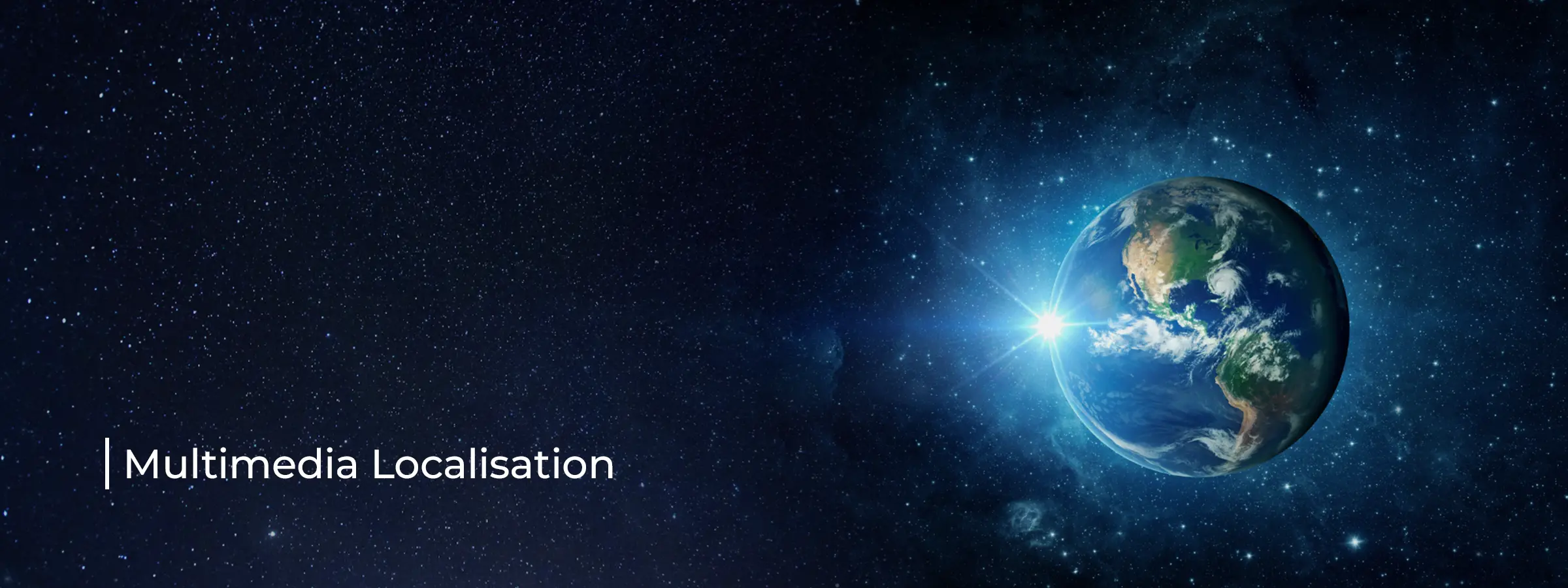What is multimedia?
Multimedia includes graphics, images, video, audio, animation, and eLearning content. Multimedia content is more engaging and enticing.
Multimedia localisation
A process of linguistic and cultural adaptation of multimedia content to meet the needs of a particular audience is known as multimedia localisation. Multimedia localisation is done to make multimedia content globally accessible. Different multimedia projects that require localisation are advertisements, corporate films, training materials, movie trailers, web banners, interactive animations, audio recordings, and entertainment videos.
Steps involved in multimedia localisation
Multimedia localisation is a complex process, and it completes in several steps:
- Transcription: The first step is the compilation of all multimedia sources, including audio, video, and mixed media. The spoken and on-screen texts are transcribed in the form of a script. This transcription is used for the further process of translation and proofreading in the target language.
- Translation: After transcription, the linguistics experts of the source language review the content to check grammar and idioms. Then the text is translated. Then the linguistic experts review the translated content of the target language to check grammar and idioms.
- localisation: Then, analyze the translated text for linguistic and cultural nuances. This includes date and time format, measurement units, and currencies. The audience consumes the localized content as original.
- Voiceover recording: Rerecord the localized transcript as a new voiceover for videos. Highly experienced and qualified technicians carried out recording using high-end studio equipment. The voiceover experts should have an apt dialect, accent, enunciation, diction, tone, and linguistic variables; this will help deliver a personalized experience to the target audience.
- Translation synchronization: After the localisation, synchronization is done. Specific software used for synchronization of text and video, dubbing, or voice. Avoid a mismatch between spoken and written words to prevent any lapses. The timing between voiceover and video should be synchronized. Subtitling is a cheaper alternative to voiceover. Synchronization is also more effortless with subtitles.
Benefits of multimedia localisation:
There are several benefits of multimedia localisation, and here we are going to discuss them:
- Increased market penetration: Localizing multimedia content increases your products’ market penetration. Localized advertisements, corporate films, and web banners are the key players in increasing global market penetration.
- Accurate feedback from customers: As you offer all the details about your products in the language of the customer, you will also receive authentic customer feedback about their experience.
- Increased sales: Localizing audio and video multimedia content will enhance the understanding of your products among the customers. Increased product understanding will increase trust in your products and ultimately increase sales.
- Increased customer satisfaction: Customers who get all the product information and support in their native languages will increase customer satisfaction.
- Staying ahead of the competition: Properly localized multimedia content will help your company stay ahead of the competition. Customers prefer to buy products from a company with product information and advertisement material in their native language.
- Attract investors: Well-localized multimedia content about your business will attract investors to your business. More investment means increased market share and more revenue generation.
How to choose a multimedia localisation provider for your business:
Finding a competent multimedia localisation provider is complicated and needs scrupulous research. The following points should be considered for choosing a multimedia localisation provider for your business:
- Communication: A multimedia localisation provider should respond quickly, communicate in a friendly manner, and provide detailed information. Communication is essential in building a trustworthy and long-term professional relationship.
- Project management: A multimedia localisation provider must provide a dedicated project manager who helps you with all your queries.
- Subject matter expertise: A multimedia localisation provider must have experience in a particular field and source and target language expertise. Check with the localisation provider if they have a certificate to prove their expertise in that field.
- Relevant tools: Check with the localisation provider which software they use to do localisation. What are the features of that software, and compare it with other software used by other localisation providers? These questions will help you in deciding whether the localisation service provider will be able to deliver your project or not.
- Scalability: Check the size of the team and tools and ensure whether the localisation provider will deliver the desired amount of content in due time.
- Reviews: Check all the reviews given by past customers of the localisation provider to know the quality of localisation work they have provided. You can also ask your friends and partners whether they have worked with this company in the past or recently.
- Before finalizing the contract with the localisation service provider, check the company’s portfolio. The portfolio gives a clear idea about the work quality and the company’s style.
White Globe as a localisation service provider
White Globe is one of the best localisation service providers in Asia. We provide multimedia localisation services across languages and lines of business. Our efficient team of technical and linguistic experts can deliver the best localisation. At the same time, our services are cost-efficient, quick, and high-quality.
FAQ
Ans: Localisation is transforming services and products into the language and culture of a particular target audience.
Ans: Translation is the process of changing one language’s text into another. The localisation includes cultural, visual, and technical adaptation along with translation.
Ans: The cost of localisation depends on the type of content, and it can be confirmed upon a thorough analysis of the localisation requirements.
Ans: The localisation providers sign confidentiality contracts and maintain them throughout the process.
